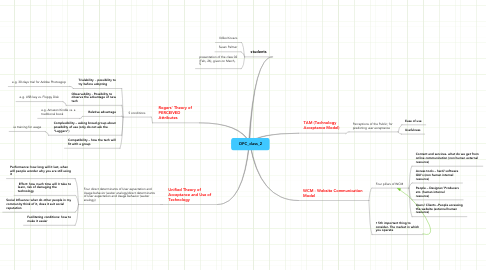
1. students
1.1. Ildiko Kovacs
1.2. Susan Palmer
1.3. presentation of the class 02 (Feb, 26), given on March, 5
2. Rogers' Theory of PERCEIVED Attributes
2.1. 5 conditions
2.1.1. Trialability - possibility to try before adopting
2.1.1.1. e.g. 30 days trial for Adobe Photosgop
2.1.2. Observability - Possibility to observe the advantage of new tech
2.1.2.1. e.g. USB key vs. Floppy Disk
2.1.3. Relative advantage
2.1.3.1. e.g. Amazon Kindle vs. a traditional book
2.1.4. Complexibility – asking broad group about possibility of use (only do not ask the "Laggers")
2.1.4.1. i.e training for usage
2.1.5. Compatibility – how the tech will fit with a group
3. Unified Theory of Acceptance and Use of Technology
3.1. Four direct determinants of User expectation and Usage behavior (waiter analogy)direct determinants of User expectation and Usage behavior (waiter analogy)
3.1.1. Performance: how long will it last, when will people wonder why you are still using it
3.1.2. Effort: how much time will it take to learn, risk of damaging the technology
3.1.3. Social Influence: what do other people in my community think of it, does it suit social reputation
3.1.4. Facilitating conditions: how to make it easier
4. WCM - Website Communication Model
4.1. Four pillars of WCM
4.1.1. Content and services- what do we get from online communication (non human external resource)
4.1.2. Access tools – hard/ software GUI’s (non human internal resource)
4.1.3. People – Designer/ Producers etc. (human internal resource)
4.1.4. Users/ Clients –People accessing the website (external human resource)
4.2. • 5th important thing to consider- The market in which you operate
5. TAM (Technology Acceptance Model)
5.1. Perceptions of the Public; for predicting user acceptance
5.1.1. Ease of use
5.1.2. Usefulness
